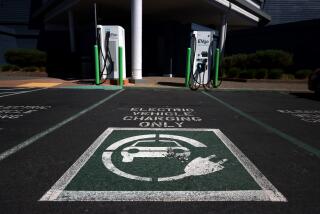Automakers ahead of schedule for 2020 fuel economy targets
- Share via
The auto industry is making significant strides toward increasing fuel efficiency and is ahead of schedule in meeting strict federal fuel economy goals, according to a new analysis by the Union of Concerned Scientists.
Already, 10% of the new passenger cars and trucks on the market today meet their federal targets for 2020 and the industry still has much room to apply state-of-the-art fuel efficiency technology to the remaining fleet, UCS said.
“The efficiency and emissions standards are working — all you have to do is look at cars and trucks that are on the road,” said Dr. Dave Cooke, vehicles analyst at UCS. “Automakers are meeting the challenge of making cleaner cars, and Americans are buying those cars.”
Automakers must produce fleets that have a so-called Corporate Average Fuel Economy of about 42 miles per gallon by 2020 and 54.5 mpg by 2025. But those numbers are compiled by mandated tests that overstate real life fuel economy and the window stickers placed on new cars.
The 2020 target is closer to 32 mpg and the 2025 is about 37 mpg, Cooke said. Vehicles that already meet or exceed those numbers include variants of nearly 100 different models, including some top sellers.
The group includes Ford’s hulking F-150 pickup truck when equipped with a 2.7 liter, turbocharged V-6 engine. The “EcoDiesel” version of the Ram 1500 pickup truck also meets the 2020 fuel standard. Other versions of top sellers meeting the standard include the four-wheel-drive Honda CR-V, the Toyota Corolla LE ECO, the Honda Civic HF and Ford’s Fusion Hybrid and Fusion Energi plug-in hybrid.
Most of the improvements are coming in normal vehicles and don’t rely on advanced technology such as battery electric drive trains or hydrogen fuel cells. About 70% of sales of vehicles that meet or exceed 2020 standards run on conventional gasoline- and diesel-powered engines, Cooke said.
“Everyone is looking for the internal combustion engine to be the main driver of these efficiency improvements over the next 10 years,” he said.
Cooke said manufacturers on average are about 1 mpg, or one year, ahead of the targets.
Researchers at the University of Michigan Transportation Research Institute are finding similar improvements.
They calculated that the average fuel economy – based on auto window stickers – of the cars, pickup trucks, vans and SUVs purchased in April was 25.2 mpg. That’s a 14% increase from April 2010.
Despite the gains so far, automakers will have to pick up the pace of fuel economy improvements after 2020. There’s a steeper curve from 2020 to 2025 than there is from this year to 2020, Cooke said.
Follow me on Twitter (@LATimesJerry), Facebook and Google+.







